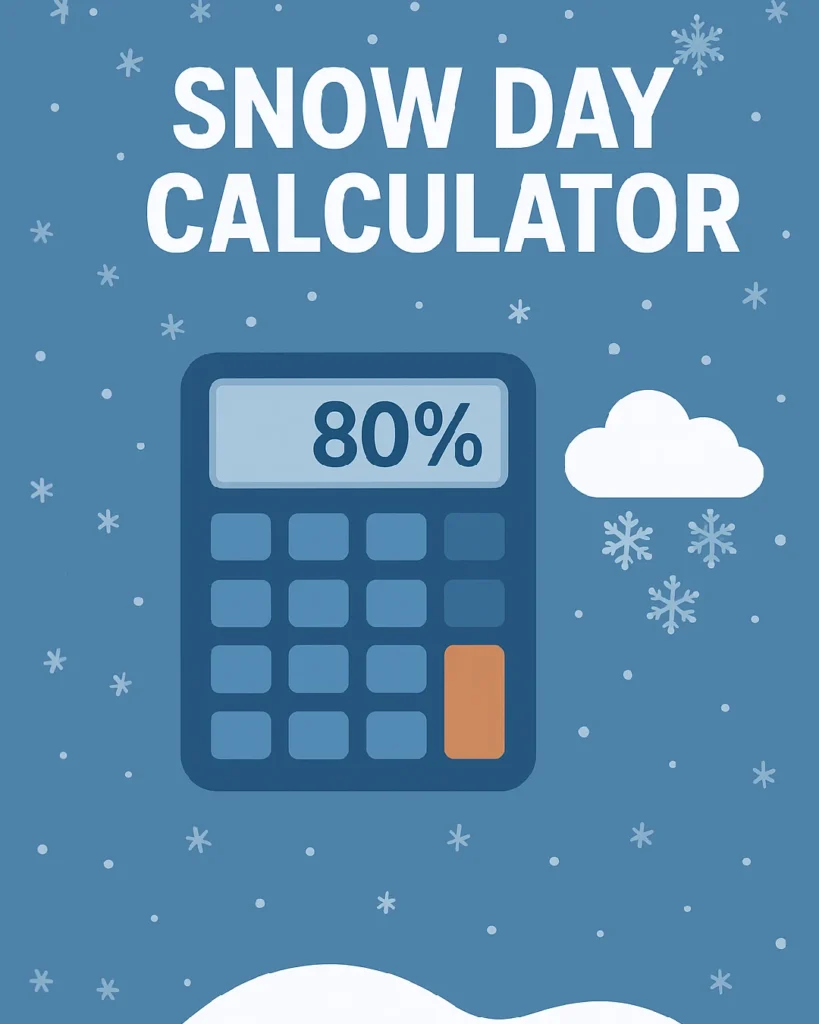Snow Calculator open the site. Enter your zip. Hit the button.
Numbers spin. Then a percentage appears — 68% chance of no school tomorrow.
Feels like a magic trick. It’s not. It’s data wearing a cozy winter sweater.
Weather is chaos. But algorithms try to tame it. These calculators don’t guess, not really. They compare. They look at snow, wind, time, temperature, the old records, the way your district panics when flakes fall. Then it predicts if buses will roll or not. It’s science mixed with psychology. And a bit of luck.
There’s no single formula. Everyone builds it differently. Some use code that looks like a crossword puzzle. Others use AI models trained on thousands of snow days. Some are hobby projects. Some are serious university-level weather models running in quiet servers somewhere in Ohio.
The Ingredients of Prediction
Snow. That’s the main actor. How much? When will it fall? If it piles up before 6 a.m., bad news.
Wind makes it worse. Drifting snow hides roads. Freezing rain adds slick horror.
Temperature sits quietly, deciding whether it’ll melt or freeze.
Then there’s history. Districts behave like creatures of habit. If they closed at four inches last year, they’ll probably do it again.
Old data never dies. It teaches the model how humans react.
Every number is a clue. NOAA, the National Weather Service, sometimes private stations. They pour data into servers every hour. That data feeds the machine. The machine spits back a number that feels almost human in its guesswork.
Some calculators even know about the roads. They pull sensor data from the Department of Transportation. Road ice reports. Plow activity. Cameras showing slush where cars slide sideways. Then it all gets mashed into one quiet percentage on your screen.
Sometimes it’s right. Sometimes it’s very wrong.
Different Flavors of Snow Magic
The Simple Ones
The simple ones use rules.
If snow > 4 inches, probability = high.
If below freezing + high wind = maybe.
If school already canceled yesterday = low chance today.
That’s it. Just rules. Easy to understand. Dumb but dependable.
The Smart Ones
Then come the smarter ones. They use regression models, which is a fancy way of saying pattern matching. They learn from history. Snow depth, wind, temperature. Thousands of rows of data. They find the curves, the “if this then that” behaviors.
The AI Beasts
AI ones go further. Random forests. Gradient boosting. Words that sound like wizards talking. They learn from everything at once. They don’t ask what rule matters most just know.
But machines aren’t gods. They can’t feel. smell the air before a storm miss the sound of heavy snow hitting windows. They see numbers. That’s all.
Some sites blend both worlds. Humans and code sharing control. A hybrid system. It learns, it listens, it updates when users say, “hey, you were wrong last night.” Over time, it gets sharper. Not perfect. Just sharper.
The Hidden Process Behind Every Prediction
It starts when you click.
Your location pings.
The tool grabs the weather forecast for your zone.
Then it runs a quiet analysis behind the screen.
First, it looks at predicted snowfall. Then timing. Is the snow starting at midnight or morning? If early, buses can’t run.
Then it looks at wind, freezing risk, temperature rise. If warm after noon, it lowers the odds.
It grabs local closure history. Compares you with districts nearby. Some close at 3 inches. Some wait for 7. Every region has its personality.
The tool weighs all of it. Adds a pinch of uncertainty. The result? A percentage. Usually between 0 and 100.
It might say: “79% chance of closure.” You stare at it like it’s gospel. But it’s just math whispering.
Sometimes it even asks you back — “Did your school close?” You tap yes or no. That answer becomes part of the system. Like a living memory bank. It grows each winter, learning from us.
Accuracy Levels: How Often Do They Get It Right?
People think these things are exact. They’re not. On a good day, 80% right. On bad weeks, just guessing better than a coin flip.
Long-range predictions? Don’t even bother. Snow three days out changes every hour.
Short-term, though, pretty solid. Especially when it’s fed local data.
Some even nail the morning calls. “School will close at 6:00 a.m.” And boom, it happens. You think it’s magic, but really, it’s timing.
One study compared predicted vs. actual closures in several U.S. districts. It found accuracy dropped sharply after 36 hours.
Weather hates being predicted.
Storms turn. Temperatures lie. People panic differently every year.
Still, these calculators hit around 70–85% accuracy on average.
Not bad for a web toy.
The Chicago Blizzard Case Study
One winter night, a storm brewed over Chicago.
Forecast said five inches. A popular snow day calculator blinked 85% chance of closure.
Morning came. Six and a half inches fell.
Buses froze in place. Schools canceled everything.
The calculator had been dead-on. People screenshotted the proof, sent it around TikTok like prophecy.
That night, the developer posted, “The model worked. Barely. I’m shocked.”
A week later, a different storm hit.
Same calculator predicted high chance.
Schools stayed open.
Parents got mad.
The tool’s reputation took a dent.
Snow prediction is a fickle art. It doesn’t care about your accuracy chart.
Why Snow Day Calculators Fail
Storms lie.
Forecasts lag.
Districts change policies overnight.
New superintendents, new budgets, new buses. One tweak and your past data becomes junk.
Some areas have microclimates. A school two miles away may get five inches more snow. The model can’t see that difference. It smooths it out.
Sometimes a plow crew works faster than expected. Roads are fine by sunrise. The model thought chaos. Instead, kids go to school.
And ice. Ice ruins everything.
One tenth of an inch, invisible but deadly. Hardly shows in the forecast.
Calculators usually miss it. That’s how you get those mornings where it “looked fine” but everyone’s slipping.
Still, people trust it. Because it’s something.
A number beats uncertainty. Even if the number lies sometimes.
Snow Day Calculator Touch Behind Tech
Developers of these tools don’t sleep much during storms.
>They watch radar maps glow like video games. They tweak code. They hope their algorithm won’t embarrass them in front of thousands of teens hitting refresh.
One said in a Reddit post, “I made this thing when I was sixteen. Now it gets 3 million hits every snowstorm. I just fix bugs at 3 a.m. and pray it doesn’t crash.”
Some tools have grown into businesses. Perry Weather, for instance. They sell prediction systems to districts directly. Combine sensors, weather stations, private forecasts. Expensive, precise.
Others? Just passion projects running on coffee and chaos.
It’s both sides of tech — the corporate and the kid coder in a hoodie. Both chasing the same dream. Predicting the unpredictable.
Trust But Verify
So next time you see 90% chance of a Snow Calculators smile, but double-check.
Check your local district’s site.
Listen to the radio.
Step outside, feel the air. Sometimes the smell of wet cold tells you more than any algorithm.











